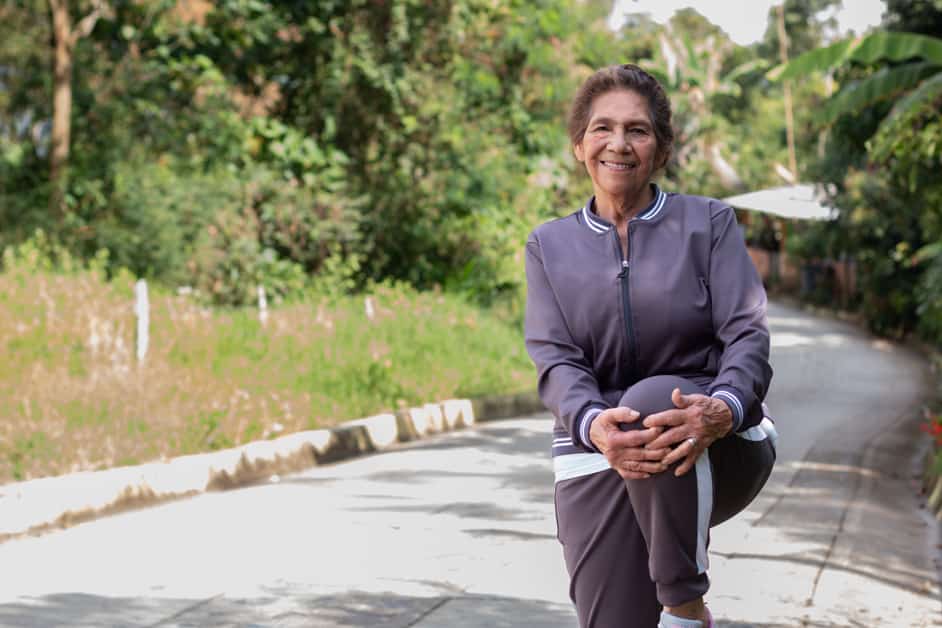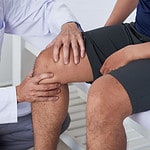Introduction
Staying active is important for good health and your knee health. It helps keep weight in the ideal range for joint health, tones muscles around the knee, boosts balance and coordination, and even fights depression! Exercise can help reduce pain for people with arthritis or knee injuries and preserve joint function.
This article covers tips to protect your knees with exercise. We’ll look at:
- Aerobic exercises for cardio benefits
- Strength exercises for knee health
Plus, we’ll discuss how to stay safe while keeping active as you age.
The Impact of Aging on Knee Health
Ageing brings with it weakening of knee joints, making them more vulnerable to injury and arthritis. This could result in chronic knee pain, which may significantly reduce your quality of life. To uphold healthy knees as we age, regular physical activity is a must.
Here, we’ll discover the impact of ageing on knee health and how regular exercise can be of help.
Loss of muscle strength
As we age, our bodies become less efficient. Coordination of our muscles begins to deteriorate, resulting in a loss of muscle strength. The muscles and tendons around the knee joint suffer the most. This can make regular activities like walking or getting up from a chair difficult for elderly people.
Aging also increases the risk of developing conditions that weaken the knee’s stability. Osteoarthritis and rheumatoid arthritis can cause inflammation, swelling and pain around the knee joint. They also wear away at cartilage, which is important for shock absorption and stability. Osteoporosis also reduces the amount of ligaments around the knee joint.
Aging affects lubrication in the knee joint too. Cartilage production decreases, causing wear on existing cartilage. This makes it hard for elderly individuals to walk comfortably or perform activities without pain or instability in their knees.
Increase of joint stiffness
Age-related joint stiffness can be a big issue for elderly people and their knee health. Signs of stiffening joints include feeling aching, tightness, and difficulty with motions. This happens because the aging body produces less joint lubricating substances. Tendons, ligaments, muscles, cartilage, and bones become less flexible, weaker, and more fragile. There are also psychological reasons why an elderly individual might not exercise.
Doing regular exercise is key to keeping joint flexibility as you get older. Low-impact activities like swimming are great for elderly individuals with limited joint movement or arthritis. The buoyancy helps them walk without stressing their knees. Strengthening the muscles around the knees (front thigh and calf muscles) helps provide stability. Leg raises increase balance and coordination, while stretches help with knee movement. Doing these activities daily or weekly can help protect against more damage and improve mobility. Exercise is beneficial at any age!
Loss of joint range of motion
Growing older can mean less joint range of motion (ROM). ROM’s how much a joint can move different ways. Less ROM can lead to stiffness and make it tough to do everyday stuff. Losing knee ROM is especially bad for staying mobile, like walking or climbing stairs.
To stop ROM from going down, exercise and stretching are musts. It’ll help reduce injuries from lower ROM. There’re exercises and stretches made just for knees, like heel slides, static quadriceps stretches, and straight-leg raises. Before trying out any ROM exercises, it’s smart to talk to a physical therapist. They can make you a plan for your specific needs.
The Benefits of Exercise
Exercise is key for keeping your joints healthy, especially your knees, as you age. Strengthening your muscles safeguards your joints from everyday activities. Plus, exercise can reduce pain and stiffness in your joints, help with mobility and balance.
Let’s explore the advantages of exercise for knee health!
Strengthens muscles and tendons
Regular exercise is great for the body, especially as we age. It helps us maintain muscle mass, strength, coordination, and balance. Strengthening muscles around the knees is important for protecting knee health. This reduces injuries and helps with existing knee problems, like arthritis or cartilage damage.
Exercises focusing on the quads, hamstrings, calves, hips, and buttocks are best to keep the knee joint stablized. They also absorb shock when you walk or run.
Examples of exercises:
- Calf raises – raising up onto toes then lowering back down.
- Lunges – keeping one foot stationary, plant another foot behind you with a bent leg then straighten leg pushing back off floor.
- Squats – start feet shoulder width apart, then sit back onto a chair, keeping heels flat on floor, then stand again.
- Cycling – both indoors and outdoors cycling strengthens all major muscles from bottom half of body with a circular motion.
Improves joint flexibility and range of motion
Exercise is a must for keeping your knees healthy. It can increase flexibility and range of motion. Strengthen the muscles and ligaments around the knee by doing low-impact activities such as walking, swimming and biking. These avoid unnecessary stress on the joints. Strength training is also beneficial. Seated leg lifts with a resistance band can help. Stretching before physical activity involving the legs is important too.
Proper diet with plenty of fruits and veggies is great for joint health. It gives you essential vitamins and minerals for healthy cartilage tissue. Exercise and diet together will keep your joints flexible, strong and lubricated. Enjoy pain free days!
Reduces inflammation and pain
Exercising is not just to make muscles stronger and more flexible, it can be great for knee health too! As we age, our knees can become inflamed and painful. Exercise helps to reduce this joint inflammation and therefore, decrease the pain.
Studies show that activities such as walking or jogging can help to reduce inflammation and pain. Exercise helps to increase circulation and get more oxygen to the joints. This helps to reduce joint stiffness. Also, activities such as walking and jogging strengthen the muscles around the knees, making them better able to support the joint and absorb shock from activities like running or climbing stairs.
The best type of exercise for your knees depends on your health needs. Some people prefer walking, while others may like low impact aerobics classes or swimming. Whatever activity you choose, regular exercise has proven benefits in helping to keep your joints healthy and pain-free.
Types of Exercise for Knee Health
Exercise is a must for keeping your knees healthy as you age! It helps to pump up the muscles that protect your knees and lower the chances of joint ache and harm.
There’re many types of exercises you can do to focus on your knees’ wellbeing. Let’s check out some of these exercises and their advantages!
Low-impact aerobic exercise
Low-impact aerobic exercises are great for preserving knee health as we age. Examples include walking, biking, swimming, and using an elliptical.
Balance exercises are also important, such as standing on one foot or walking heel to toe. This can build lower body strength and improve balance.
Stretching exercises can also help improve flexibility and range of motion. These include:
- Hip flexor stretches
- Quadriceps stretches
- Calf stretches
- Lateral lunges
- Deep curtsy squats
- Inner thigh stretches
All of these should be done slowly and with control.
Strength training
Strength training should be a key part of any exercise plan for knee health. It strengthens the body and reduces the strain on the knees by building muscle. To help with balance and stability, it can construct strong muscles in the quads, hamstrings, and glutes.
Recommended exercises include:
- Squats
- Lunges
- Step-ups
- Wall sits
Do these slowly and with a full range of motion. Avoid locking or hyperextending the knee joint. Do not twist the hips when doing weight-bearing exercises as that can cause injury. Resistance bands are great for those who are not confident with weights or have limited access to them.
Take time to stretch before and after strength exercises. This will help with flexibility and reduce the risk of injury due to stiff joints and muscles pulling on each other too much.
Stretching and flexibility exercises
As we age, our joint motion decreases, causing more harm. Stretching and flexibility exercises help ensure knee health and performance. They make the joint more flexible, reduce stiffness, and reduce your danger of being injured. When taking care of your knees, there are multiple stretching exercises to consider:
- Static stretching: Lengthen a muscle and maintain the position for 15-30 seconds. E.g seated forward fold with extended feet.
- Dynamic stretching: Active moves to warm up muscles before vigorous activity. E.g walking lunges or arm circles.
- Range-of-motion exercises: Move the knee through its full range of motion (flexion and extension). E.g leg raises for the quadriceps or gentle straight-leg raises for the hamstrings.
- Balance training exercises: Doing exercises like standing on one leg or using an exercise ball improve dynamic balance.
Conclusion
Conclusion? Exercise is important for health as we age. It reduces the risk of osteoarthritis and knee pain. To get the best outcomes, start exercising in your 40s and 50s. Get professional advice if needed. Balance rest and activity to avoid injury. Staying active will help us stay independent longer and keep our knees healthy.
Frequently Asked Questions
Q: How does exercise help maintain knee health as you age?
A: Regular physical activity strengthens the muscles that support the knee joint and helps maintain flexibility, balance and overall joint health. Exercise also helps maintain a healthy weight, which is important for reducing the strain on your knees.
Q: What types of exercises are beneficial for maintaining knee health as you age?
A: Low-impact aerobic activities such as walking, swimming, and biking are beneficial for maintaining knee health. Additionally, strength exercises such as squats and lunges can help build the muscles that support the knee joint.
Q: What precautions should I take when exercising to maintain knee health?
A: Warm up and stretch before beginning any exercise, and avoid any activities or exercises that cause pain in the knee. Additionally, it is important to maintain proper form when doing any type of exercise to ensure that you are not putting any unnecessary strain on your knees.





